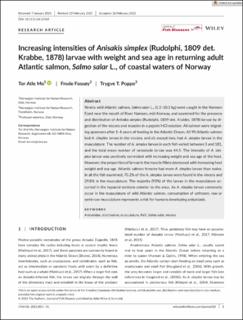Increasing intensities of Anisakis simplex (Rudolphi, 1809 det. Krabbe, 1878) larvae with weight and sea age in returning adult Atlantic salmon, Salmo salar L., of coastal waters of Norway
Peer reviewed, Journal article
Published version

Åpne
Permanent lenke
https://hdl.handle.net/11250/3041252Utgivelsesdato
2021Metadata
Vis full innførselSamlinger
- Publikasjoner fra CRIStin - NINA [2364]
- Scientific publications [1392]
Sammendrag
Ninety wild Atlantic salmon, Salmo salar L., (1.5–10.3 kg) were caught in the Namsen Fjord near the mouth of River Namsen, mid-Norway, and examined for the presence and distribution of Anisakis simplex (Rudolphi, 1809 det. Krabbe, 1878) larvae by di-gestion of the viscera and muscles in a pepsin/HCl solution. All salmon were migrat-ing spawners after 1–4 years of feeding in the Atlantic Ocean. All 90 Atlantic salmon had A. simplex larvae in the viscera, and all, except two, had A. simplex larvae in the musculature. The number of A. simplex larvae in each fish varied between 3 and 181, and the total mean number of nematode larvae was 44.5. The intensity of A. sim-plex larvae was positively correlated with increasing weight and sea age of the host. However, the proportion of larvae in the muscle fillets decreased with increasing host weight and sea age. Atlantic salmon females had more A. simplex larvae than males. In all the fish examined, 70.2% of the A. simplex larvae were found in the viscera and 29.8% in the musculature. The majority (93%) of the larvae in the musculature oc-curred in the hypaxial sections anterior to the anus. As A. simplex larvae commonly occur in the musculature of wild Atlantic salmon, consumption of unfrozen, raw or semi- raw musculature represents a risk for humans developing anisakiasis.KEYWORDSAnisakidae, distribution, musculature, RVS, Salmosalar, viscera
